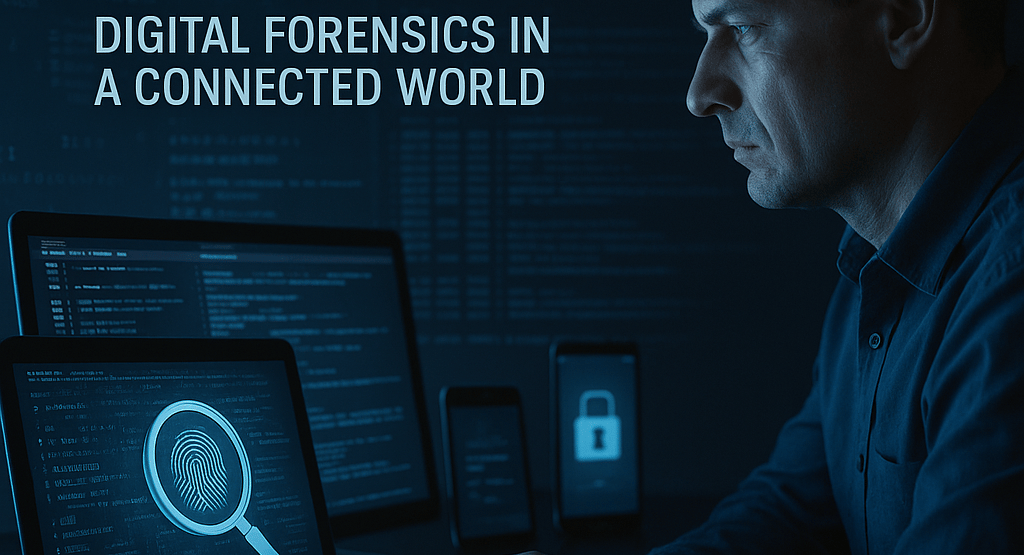Where Silence Speaks: Digital Forensics in a Connected World
https://www.linkedin.com/in/kanhaiya-lal-patidar-3b9266287 https://www.linkedin.com/in/aman-singh-68a7bb2a5/ https://www.linkedin.com/in/dheeraj-khokhar-31a163320/
Kanhaiya lal Patidar, Aman Singh, Dheeraj Khokhar
8/6/20252 min read


Where Silence Speaks: Digital Forensics in a Connected World
A crime scene doesn’t always begin with broken locks or bloodstains. In today’s world, it might start with a login attempt, an encrypted message, or a trace left behind by a disconnected USB. While traditional forensics uncovers evidence from the tangible world, digital forensics ventures into the unseen — where machines remember more than people do.
Every device we touch leaves behind fragments of our actions—timestamps, cache files, command-line remnants, deleted photos that aren’t truly gone. These are not accidental leftovers; they are structured fragments of truth, waiting for someone to know where—and how—to look.
Not a Parallel Field, but a Critical Layer
Digital forensics is no longer the backstage technician—it has become the main theatre for many modern investigations. When physical clues fall short, digital remnants carry the weight of proof. Whether it’s a corporate insider leaking confidential data or a suspect hiding behind layers of anonymity, the system logs everything—it’s just a matter of interpretation.
This field isn’t simply about recovering data—it’s about reading the intent behind it. Why was a folder deleted seconds before a suspect’s arrest? Why did a phone switch networks the day of a disappearance? Why is a device encrypted using a rarely used cipher? These aren’t just technical anomalies—they are clues wrapped in code.
Redefining the Idea of a “Crime Scene”
Traditionally, a crime scene was a defined space—a house, a street, a body. But now, it’s spread across devices, servers, cloud platforms, and sometimes even dark web forums. The crime might be committed in Mumbai, the evidence stored in Frankfurt, and the suspect posting from a VPN routed through Singapore. The battlefield has shifted—and so has the need for precision, speed, and cross-border expertise.
Digital forensics is not about catching the criminal in the act—it’s about reconstructing their digital shadow with accuracy, and presenting that truth in a way courts can accept. It’s about timelines, correlations, anomalies, and most importantly, context.
Precision Matters More Than Ever
In a digital investigation, a second can make the difference between coincidence and conviction. The wrong interpretation of a log file can mislead an entire case. That’s why digital forensic professionals operate like surgeons—removing, preserving, and examining without altering a single byte.
Modern digital forensics requires:
• Advanced Imaging: Capturing entire disks, cloud drives, or mobile storage without compromising integrity.
• Memory and Live Forensics: Extracting volatile data before it’s lost forever during shutdown.
• Log Analysis and Timeline Reconstruction: Piecing together digital movements, file access history, and user behavior over time.
• Encryption and Obfuscation Handling: Dealing with encrypted environments, steganography, anti-forensic tactics.
• Legal Mapping: Ensuring every step is compliant with jurisdictional standards for admissibility.
From Devices to Testimony
The ultimate goal of digital forensics is not just discovery—it’s translation. Turning technical findings into evidence that speaks in a courtroom, to lawyers, judges, and juries. And that translation requires not only technical mastery, but a deep understanding of human behavior, legal procedure, and investigative thinking.
Closing Thoughts: Digital Truth is Relentless
The difference between a solved and unsolved case might no longer be a DNA sample—it might be a server log or the hash value of a deleted email. In an age where crimes are increasingly invisible, the pursuit of justice depends on those who can see what machines saw, and make sense of silence.
At Cipher Sentinel, we believe digital evidence is not just data—it’s testimony in waiting. And in this age of rapid digital acceleration, the truth doesn’t always lie in what’s seen, but in what’s left behind in the layers of code.
Products
Expert cybersecurity and forensics for your business.
Resources
© 2025. All rights reserved.
Note : Most of the Products and Services offered by us are meant for Government, Defence and Law Enforcement Organisations and are required to be used in Ethical manner for National Interest. Usage of Products should be as per the Local Government Regulation/ Norms.